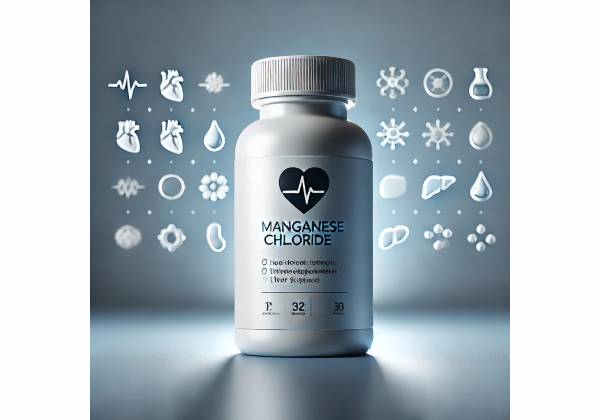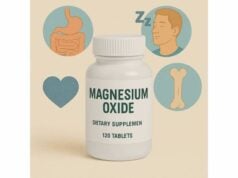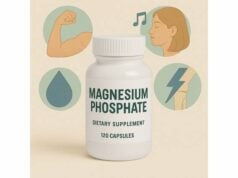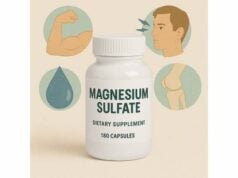
Manganese chloride is a supplemental and pharmaceutical source of manganese, an essential trace mineral your body uses in tiny amounts every day. In nutrition, “manganese (as manganese chloride)” on a label means the product provides elemental manganese—the biologically relevant portion—paired with chloride as the counter-ion. Manganese is a cofactor for antioxidant defenses in mitochondria, helps enzymes that build cartilage and bone, and supports normal blood clotting and energy metabolism. Most adults meet their needs through food (whole grains, nuts, legumes, tea), yet low, well-chosen supplemental amounts can be appropriate when diets are limited, multivitamins aim to “cover bases,” or a clinician recommends a specific intake. The same chemical, manganese chloride, is also used in hospital settings as a prescription trace-element injection for patients on long-term parenteral nutrition—this clinical use differs from over-the-counter oral supplements and follows strict dosing to avoid accumulation. This guide focuses on practical, people-first questions: what manganese chloride is, what benefits are realistic, how to dose by elemental manganese, what affects absorption, how to avoid common mistakes, and who should steer clear or seek supervision.
Key Facts
- Supports mitochondrial antioxidant enzymes and connective-tissue formation; best used to meet daily needs, not exceed them.
- Typical supplemental range: 1–3 mg elemental manganese/day; total intake should stay well below 8–11 mg/day.
- Separate minerals from tetracyclines and fluoroquinolones by several hours to avoid reduced antibiotic absorption.
- Avoid unsupervised use in chronic liver or biliary disease, iron deficiency, or when environmental exposure to manganese is high.
Table of Contents
- What is manganese chloride?
- Benefits and what to expect
- How to use and dose correctly
- Factors that change absorption
- Mistakes and troubleshooting
- Side effects and who should avoid
- Evidence at a glance
What is manganese chloride?
Manganese chloride is a salt in which each manganese ion (Mn²⁺) is paired with chloride. In supplements, it functions as a source of elemental manganese, the small portion your body actually uses. Labels in many regions list “Manganese (as manganese chloride),” with the number referring to elemental manganese—not the full weight of the salt. That distinction matters because safety guidance and daily targets are framed in elemental terms.
Why the body needs manganese: it activates enzymes central to daily physiology. Manganese superoxide dismutase (MnSOD) is the chief antioxidant enzyme inside mitochondria, protecting cells from routine oxidative by-products of energy production. Other manganese-dependent enzymes support the formation of cartilage and bone matrix, influence carbohydrate and amino acid metabolism, and assist normal blood-clotting function alongside vitamin K. Your total body manganese stores are small (roughly a few tens of milligrams), with a substantial fraction in bone and meaningful amounts in the liver, pancreas, and brain.
How manganese chloride compares to other forms: you will also see manganese sulfate, gluconate, citrate, bisglycinate, and ascorbate. At the low micro-doses appropriate for nutrition (generally 1–3 mg/day elemental), there is no decisive human evidence that one oral form consistently outperforms another in bioavailability. Because the intestine and liver regulate manganese tightly—absorbing only a small fraction and excreting most excess via bile—total intake and medical context matter more than the specific salt.
A hospital-only caveat: manganese chloride is also an ingredient in prescription parenteral nutrition trace-element mixtures. Intravenous manganese bypasses normal gut regulation and is dosed in micrograms under close monitoring to prevent accumulation. This is fundamentally different from over-the-counter oral use and should never be replicated with oral products.
When supplementation might be considered: if your diet skews low in whole grains, nuts, and legumes; if you take a multivitamin supplying modest manganese to ensure adequacy; or if a clinician recommends a defined intake for a time-limited plan. For many adults with varied diets, additional manganese is unnecessary.
Benefits and what to expect
With essential minerals, “benefit” usually means two things: preventing low intake and supporting enzyme systems that run in the background. Manganese chloride, as a source of elemental manganese, fits this profile. The realistic upsides are steady and foundational rather than dramatic.
Mitochondrial antioxidant defense
MnSOD neutralizes superoxide radicals generated during normal metabolism. Adequate manganese ensures this enzyme functions properly, helping protect tissues from everyday oxidative stress. You are unlikely to feel this in the short term, but it contributes to cellular resilience over time, especially under metabolic demands like exercise.
Connective tissue and bone support
Manganese-dependent enzymes help build proteoglycans, key components of cartilage and bone matrix. Inadequate manganese intake can impair these processes; adequacy helps keep them on track alongside other nutrients such as protein, vitamin C, vitamin D, vitamin K, calcium, and magnesium. While manganese alone does not increase bone density in well-nourished adults, ensuring it is not the limiting factor is reasonable, particularly in comprehensive bone-health programs.
Energy metabolism
Enzymes requiring manganese appear in carbohydrate and amino acid pathways. In practical terms, adequate manganese supports normal metabolic throughput rather than providing a stimulant-like “energy boost.” It is not a substitute for sleep, training, or calorie balance.
Joint health formulas—what role manganese plays
Some joint supplements include manganese (sometimes as manganese ascorbate) alongside glucosamine and chondroitin. Trial evidence for symptom relief in knee osteoarthritis is mixed across formulations; when benefits occur, they reflect the combination, with manganese included for its supportive enzyme roles. Do not expect manganese by itself to relieve pain; view it as part of a broader joint-care strategy involving movement, weight management, sleep, and first-line therapies.
Who is most likely to benefit?
People with consistently low dietary intake of manganese-rich foods, those using a multivitamin to cover micronutrient bases, and individuals assembling a carefully dosed bone or joint support plan. Those seeking quick relief from fatigue, weight concerns, or chronic pain will be disappointed; manganese does not act like a drug, and more is not better.
What manganese chloride does not do
It does not accelerate weight loss, enhance athletic performance in a direct way, or treat neurological disease. It is not a primary therapy for glycemic control or lipid abnormalities. Claims beyond enzyme adequacy should be met with healthy skepticism.
How to use and dose correctly
Dose by elemental manganese, not by the weight of manganese chloride. Always add up your total daily elemental manganese from all supplements, fortified foods, and diet.
Everyday guideposts
- Adequate intake from food for most adults is around 2 mg/day (about 2.3 mg/day for men and 1.8–2.0 mg/day for women).
- Many multivitamins provide 1–3 mg/day elemental manganese.
- Standalone manganese products sometimes list 5–20 mg per serving—amounts that typically exceed needs for routine use.
Practical supplemental range
For healthy adults who choose to supplement, a cautious, practical elemental range is 1–3 mg/day, usually covered by a multivitamin or a single low-dose capsule. This supports enzyme adequacy without pushing toward safety ceilings.
Safety ceilings to respect
- In the United States, the Tolerable Upper Intake Level (UL) for adults is 11 mg/day from all sources. The UL is a boundary, not a goal.
- In Europe, the food safety authority set a safe level of intake of 8 mg/day for adults (including pregnancy and lactation) based on high-consumer exposure; safe levels for youth are lower by age.
Timing and scheduling
Take manganese chloride with a meal for comfort and consistency. If you also take iron, calcium, or magnesium in substantial doses, consider spacing them apart to reduce competition and stomach upset. If you are prescribed tetracyclines or fluoroquinolones, separate mineral supplements by several hours to prevent reduced antibiotic absorption.
How long to use it
If you are filling a dietary gap, low-dose use can be ongoing, provided your overall intake stays conservative and your health context is stable. If you are trialing a joint-support formula that includes manganese, reassess after 8–12 weeks; continue only if you experience meaningful benefit and your clinician agrees the plan makes sense.
Special situations
- Pregnancy and lactation: prioritize food-first; if supplementing, keep total manganese comfortably below adult safe levels unless your clinician directs otherwise.
- Children: never extrapolate adult doses; pediatric use requires age-appropriate products and professional guidance.
- Parenteral nutrition: manganese chloride injections are clinician-dosed in micrograms for patients on long-term IV feeding; this is not comparable to oral supplements.
A simple template
- Inventory manganese in your multivitamin and any blends.
- If intake is already ≥1–3 mg/day from supplements and your diet includes manganese-rich foods, skip additional manganese.
- If your diet is limited and your multivitamin lacks manganese, consider 1–2 mg/day elemental manganese as manganese chloride with a meal, then re-evaluate in 2–3 months.
Factors that change absorption
Manganese absorption is modest (often a few percent) and dynamically regulated; the body absorbs more when intake is low and less when intake is high. Excretion occurs mainly through bile, which means liver and biliary health strongly influence manganese balance.
Iron status
Iron deficiency increases intestinal expression of transporters that can also carry manganese. As a result, iron-deficient individuals may absorb more manganese from the same oral dose, raising the risk of accumulation. Correct iron deficiency first; then reassess whether manganese supplementation is even necessary.
Diet composition
Whole grains, legumes, nuts, and tea are top manganese sources. If you increase these foods while also adding a supplement, your total exposure can climb. Phytates and certain fibers in plant foods can bind divalent minerals, but in realistic mixed diets, this effect is balanced by quantity and frequency of intake across the day.
Competing minerals
High-dose iron, calcium, and magnesium can modestly reduce manganese absorption when taken together. The practical solution is simple: do not take all minerals in one bolus unless your clinician instructs you to; space them out to improve tolerability and consistency.
Beverages
Tea and coffee contribute manganese while polyphenols may complex minerals. For most adults, the net effect is small and not clinically important, but remember to count beverages as contributors to total intake if you drink them daily.
Water and environment
Private wells can contain elevated manganese. If you use well water, consider testing; if levels are high, focus on remediation rather than adding supplements. Occupational inhalation exposure (e.g., welding fumes) is a different pathway than diet and should be managed by workplace safety, not by nutrition alone.
Gut and hepatic health
Because manganese leaves via bile, cholestasis, cirrhosis, or biliary obstruction can reduce excretion. In those contexts, even low supplemental doses may be inappropriate without specialist oversight.
Form differences in the real world
For manganese, current human data do not establish a consistent absorption advantage of one oral form (chloride vs sulfate vs gluconate vs bisglycinate) at typical micro-doses. Choose a well-made product you tolerate, and let elemental dose, duration, and your health context guide decisions.
Mistakes and troubleshooting
Mistake: Treating the UL as a target
The UL (11 mg/day in the U.S.) and the European safe level (8 mg/day) are ceilings, not goals. Staying well below them reduces risk, especially when your diet already supplies manganese.
Mistake: Double-counting across products
It is easy to stack a multivitamin (2 mg), a joint formula (another 2–3 mg), and a standalone manganese capsule (5–10 mg) without realizing it—plus food and water. Fix: read every label; total elemental manganese across the day and trim redundancy.
Mistake: Chasing nonspecific symptoms
Taking manganese for fatigue, hair issues, or “metabolism” without evaluation is unlikely to help and may add risk. Fix: bring broad symptoms to a clinician for a full workup; manganese is seldom the limiting factor.
Mistake: Ignoring liver or biliary conditions
Because manganese is excreted via bile, impaired flow increases accumulation risk. Fix: if you have liver disease or cholestasis, avoid self-supplementation and discuss micronutrients with your specialist.
Mistake: Taking with interacting antibiotics
Minerals can bind tetracyclines and fluoroquinolones in the gut, reducing antibiotic absorption. Fix: separate doses by several hours based on pharmacy guidance or pause nonessential minerals during therapy.
Troubleshooting quick answers
- Mild stomach upset: take with food or at a different time of day.
- No benefit after 12 weeks on a joint blend: reassess the full plan; discontinue if results are not meaningful and pivot to proven first-line measures.
- Worried about total exposure: inventory diet, supplements, and water; aim for the low end of supplemental intake if exposure from food and beverages is substantial.
When manganese chloride makes sense: you need a precise, low, labeled amount of elemental manganese to round out a conservative multinutrient plan, with attention to interactions and your personal risk factors.
Side effects and who should avoid
Typical tolerability
At low supplemental intakes (about 1–3 mg/day elemental), manganese chloride is generally well tolerated. Occasional mild gastrointestinal discomfort can occur when minerals are taken on an empty stomach; taking with a meal usually resolves it.
Early signs of getting too much
Persistent high intake or impaired excretion can lead to accumulation over time. Early nonspecific symptoms may include headache, irritability, sleep changes, or subtle coordination issues. With sustained excess, neurological signs resembling parkinsonism (slowed movement, tremor, gait changes) can emerge. This scenario is uncommon at prudent oral intakes but underscores why staying below safety ceilings matters.
Who should avoid or seek medical supervision
- Chronic liver or biliary disease (cholestasis, cirrhosis, bile duct obstruction).
- Iron deficiency not yet corrected (absorption is increased).
- Infants and children (age-specific safe levels are lower; pediatric guidance required).
- Pregnancy and lactation at high supplemental intakes (use diet-first or a clinician-selected prenatal).
- Occupational exposure to manganese (e.g., welding); do not add supplements without professional review.
- Existing parkinsonian symptoms or unexplained neurologic signs; get evaluated rather than self-supplementing.
Drug and nutrient timing
- Tetracyclines and fluoroquinolones: separate mineral supplements by hours to avoid chelation and reduced antibiotic absorption.
- High-dose iron, calcium, magnesium: space doses to reduce competition and GI upset.
- Levodopa and thyroid hormone: as with many minerals, conservative separation is reasonable; follow clinician or pharmacist guidance.
Allergy and excipients
Manganese chloride itself is not a common allergen, but capsule fillers vary. If you have food sensitivities, choose brands that disclose excipients clearly and consider third-party certified products.
Seek care if
You experience new neurological symptoms, persistent headaches, or mood changes while using multiple manganese-containing products or higher-dose regimens. Stop supplementation and consult a clinician.
Evidence at a glance
What is well established
- Essential roles: Manganese is required for MnSOD (mitochondrial antioxidant defense) and for enzymes that build cartilage and bone matrix, support coagulation processes with vitamin K, and participate in carbohydrate and amino acid metabolism.
- Tight regulation: Adults typically absorb a small fraction of oral manganese and excrete excess via bile; this guards against overload when liver and biliary function are normal.
- Adequate intake vs. surplus: Most adults meet daily needs through diet. Multivitamins commonly add 1–3 mg/day to provide a buffer when intake varies. Additional standalone manganese is often unnecessary in balanced diets.
- Safety boundaries: The U.S. UL is 11 mg/day for adults; Europe’s food-safety authority advises a conservative safe level of 8 mg/day for adults, with lower safe levels for youth. These boundaries account for total exposure from food, beverages, supplements, and water.
- Form comparisons: Across mainstream oral forms—including manganese chloride—human data do not show a consistent, clinically meaningful bioavailability advantage at low doses. Dose discipline and health context drive safety more than form does.
- Interactions: Multivalent minerals can interfere with absorption of tetracyclines and fluoroquinolones if taken together; simple separation in time avoids the issue.
What remains uncertain or limited
- Whether any oral manganese form offers a clinically significant absorption edge in real-world dosing.
- The extent to which supplemental manganese benefits joint symptoms independently of combination formulas.
- Biomarkers that reliably reflect tissue manganese status in free-living adults; routine blood testing is not very informative.
Practical synthesis
For most adults, the smart strategy is conservative: prioritize manganese-rich foods; if supplementing, cap total elemental manganese from supplements in the low single-digit milligrams and stay well below regional safety ceilings; avoid use in settings where absorption or retention is increased; and separate minerals from susceptible medications. If in doubt, simplify—remove overlapping products and re-build your plan around diet, a vetted multivitamin if warranted, and targeted additions only when a clear need exists.
References
- Manganese – Health Professional Fact Sheet 2021 (Guideline)
- Scientific opinion on the tolerable upper intake level for manganese 2023 (Guideline)
- Manganese Toxicity – StatPearls 2023
- Multivalent cations interactions with fluoroquinolones or tetracyclines: A cross-sectional study 2021
Disclaimer
This article is for general education and is not a substitute for professional medical advice, diagnosis, or treatment. Always consult a qualified healthcare professional about supplements, especially if you are pregnant or breastfeeding, managing a medical condition (notably iron deficiency or liver and biliary disease), have occupational exposure to manganese, or take prescription medications. Never attempt to use prescription trace-element injections outside clinical supervision.
If this guide helped you, please consider sharing it on Facebook, X (formerly Twitter), or any platform you prefer, and follow us for future evidence-informed articles. Your support helps us continue creating clear, useful health content.










